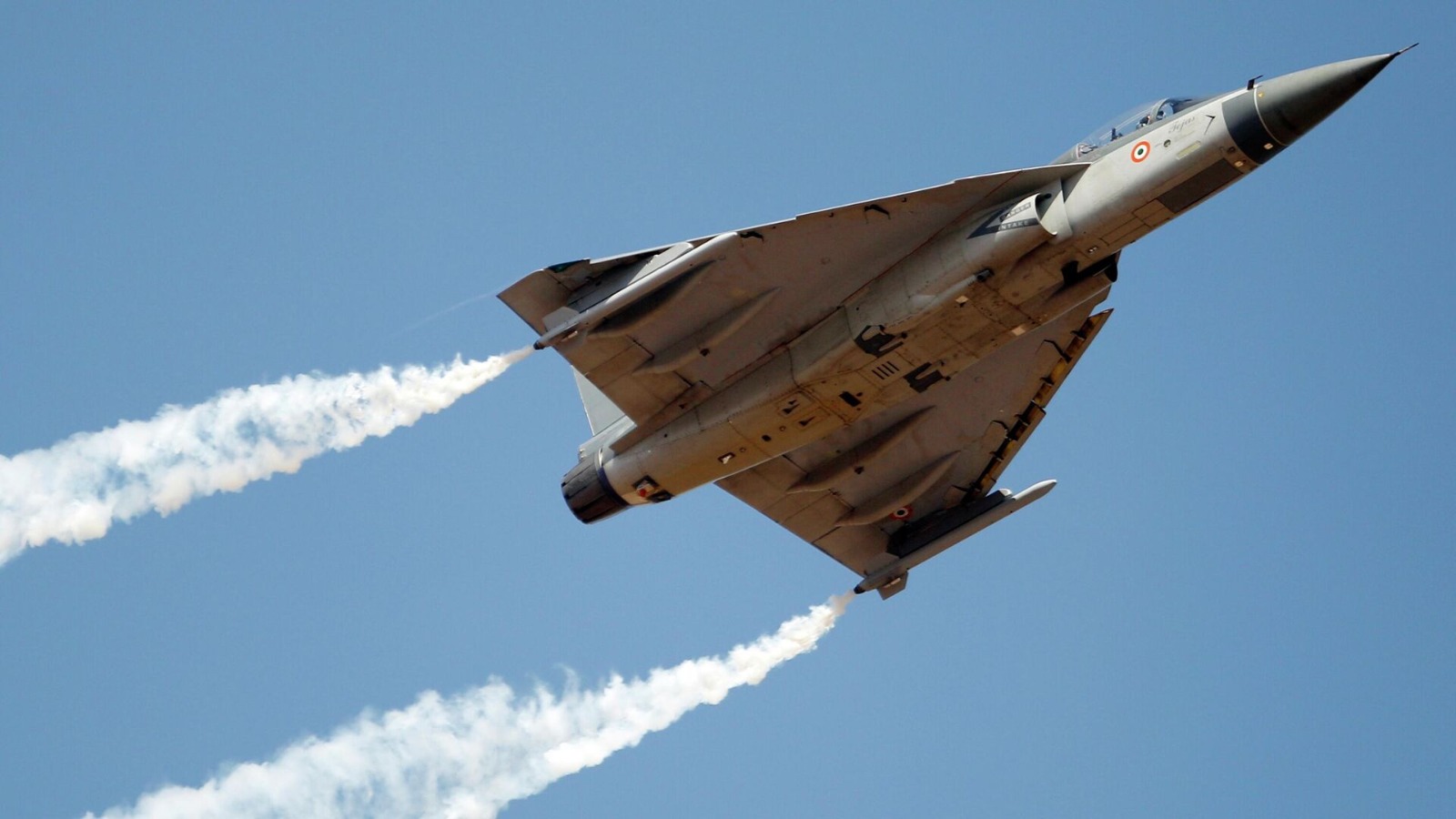India’s indigenous fighter jet, LCA Tejas, crashed today in Rajasthan’s Jaisalmer near a hostel complex. This is the first-ever crash of a light combat aircraft in 23 years.
Today, an Indian Air Force Tejas LCA Aircraft crashed during an operational training sortie near Jaisalmer, Rajasthan. The pilot successfully ejected using the Martin-Baker IN16G Seat.#MartinBaker #EngineeringForLife pic.twitter.com/Yf8qEsAgSd
— Martin-Baker (@MB_EjectEject) March 12, 2024
Meanwhile, Martin-Baker said in a tweet – today, an Indian Air Force Tejas LCA Aircraft crashed during an operational training sortie near Jaisalmer, Rajasthan. The pilot successfully ejected using the Martin-Baker IN16G Seat.
The Light Combat Aircraft (LCA) Tejas stands as a testament to India’s technological prowess and determination to achieve self-reliance in defense. Developed by the Aeronautical Development Agency (ADA) in collaboration with Hindustan Aeronautics Limited (HAL), the Tejas has become a symbol of India’s aerospace capabilities.
BREAKING: An Indian Air Force LCA Tejas fighter has crashed in Jaisalmer. Pilot thankfully ejected safely. This is the first crash of the indigenous jet since it first flew 23 years ago. An incredible safety record sadly broken today. pic.twitter.com/UkwXwWXKlk
— Shiv Aroor (@ShivAroor) March 12, 2024
The LCA program was initiated by the Government of India in 1984 with the aim of replacing the aging Mig-21 fighter planes. The establishment of the ADA under the Department of Defence Research and Development marked a significant milestone in this endeavor.
🚨#BreakingNews
An Indian Air Force LCA Tejas fighter has crashed in Jaisalmer. Pilot thankfully ejected safely. This is the first crash of the indigenous jet since it first flew 23 years ago. pic.twitter.com/vrhbrQQNOE— 𝐒𝐔𝐌𝐈𝐓 (@OyeeSumit) March 12, 2024
Tejas – Gears-Up For Action
LCA’ Tejas,’ meaning ‘brilliance or radiance,’ has been the prized production of the Indian Aerospace maker Hindustan Aeronautics Limited (HAL). The fighter jet, which has taken a long time in development, has fuelled the country’s ambition to design, develop, and deploy an Indian fighter jet.
Tejas catapulted India into the elite group of countries that have demonstrated the capability to develop their 4th generation fighter jets, equipped with electronic fly-by-wire control systems, onboard situation awareness displays, and over-the-horizon strike capabilities.
Now, with LCA Mk 1A, the HAL will demonstrate the maturity of the technology.
As reported by the EurAsian Times earlier, the IAF’s Number 3 Squadron, Cobras, will be the first unit to operate LCA Mk 1A as it retires its MiG-21 Bisons.
The Mark 1A will have more than 40 improvements from the Mark 1 that are already operational. The new variant of Mark1A has improvements such as air-to-air refueling, beyond-visual-range or BVR capabilities, and the capacity to jam enemy radars.
The IAF has placed orders for 83 LCA Mk1A aircraft in 2021, and the government has cleared decks for an additional order of 97 LCA MK 1A. The first version of the aircraft was inducted into the IAF in 2016.
Currently, two squadrons of IAF, 45 Squadron and 18 Squadron, are fully operational with LCA Tejas. In the coming years, Tejas will be the largest fleet of fighter aircraft to be operated by the IAF.
HAL currently can build 8 LCA aircraft per year. This will be augmented to 16 aircraft every year by 2025 and 24 aircraft every year in the next three years.
The schedule specifies that the deliveries of LCA MK 1A will likely be spread over the next four years. The IAF is banking heavily on the LCA Tejas to compensate for the deficiency in fighter squadrons.
The LCA MK 1A will make up for the phased-out MiG-21s, MiG-23, and Mig-27 fighter jets. The force has planned to retire its MiG-29s, followed by Mirages and Jaguars in due course of time. The indigenous LCA Tejas will form the bulk of the IAF’s muscle in the coming decade.
About half of the Mk1A Tejas fighter jets will carry the Israeli AESA radar, which is more advanced than the pulse Doppler radar mounted on the trainer jets. Starting around 2026, the remaining LCA MK1A will carry the indigenously developed top-of-the-line Gallium Nitride Uttam AESA radar, which is exponentially more powerful than Gallium Arsenide radar.
The Gallium Nitride Uttam AESA radar will allow a Tejas jet to land a mightier punch much earlier and from much farther away.
These fighter jets are to be armed with the indigenous air-to-air Astra missile. The Astra air-to-air missile is among the most sophisticated missiles in the world. In August 2023, the LCA successfully fired the Astra indigenous Beyond Visual Range (BVR) air-to-air missile off the coast of Goa.
More than $1.1 billion have been sanctioned for the development of LCA Mk 2, an updated and more lethal version of LCA Tejas. To further promote indigenization, including the aircraft engine, the Transfer of Technology for manufacturing the GE engine in India was negotiated with GE during Prime Minister Narendra Modi’s visit to the US in June 2023.

The Coming Of Age Of Tejas
A dream seen by Indira Gandhi and realized by Narendra Modi, the program to develop an indigenous fighter jet started in 1984 under the leadership of Prime Minister Indira Gandhi. It took another 17 years before the prototype undertook its maiden flight, and it took another 15 years for the IAF to induct the combat jet.
The biggest handicap the Tejas has so far has been that it is not combat-proven and has never faced a challenge, as its Indian peninsular deployment meant it is a peace-time combat jet.
But all that could change if Tejas is permanently deployed in one of India’s forward air bases facing west or north, and it would need to patrol the skies over India’s two volatile borders.
The IAF has already begun sending the existing two LCA squadrons on detachments to forward air bases along the western and northern frontiers, as was witnessed recently with a squadron in Awantipur in Jammu and Kashmir for training.
It is also aggressively pursuing the sale of the LCA to foreign air forces. The IAF’s confidence in the flying machine has been demonstrated by its willingness to deploy it to forward bases.
Prime Minister Modi also endorsed the project after he flew in the twin-seater Tejas at HAL in November 2023. This was the first sortie in any fighter jet by an Indian prime minister.
After this, Tejas’s only remaining milestone is to bag a foreign export order, for which India has been putting its complete diplomatic force behind it.
Unlike its regional rivals China and Pakistan, India did not face any problems in sourcing components for its fighter jet. The big-ticket item it has is the US engine powering it.
China’s jet fighter development programs have repeatedly been held back by Russia’s unwillingness to supply high-performance engines for fear of Chinese reverse engineering. Key components and the design of Pakistan’s locally manufactured JF-17 are entirely sourced from China.
Tejas has already been challenging JF-17 in the international market, and the Mk-1A variant will add more firepower to the fight.
- Ritu Sharma has been a journalist for over a decade, writing on defense, foreign affairs, and nuclear technology.
- She can be reached at ritu.sharma (at) mail.com
- Follow EurAsian Times on Google News




